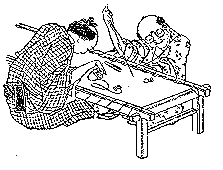Click on thumbnails to see fullsize picture
These first professional photographers both set up shop in 1862.
Both encountered many difficulties at the
outset but eventually became very succesful.
Originally born in Venice, Beato was one of the first
official photographers appointed to the Crimean War in 1855.
Afterwards he travelled to the Middle East, India and China. In 1861 his friend
Charles Wirgman asked him to join him in Japan. Together they set up a photo
studio in Yokohama.
In Japan, Beato portrayed some sensational scenes, like crucified and
decapitated Japanese criminals, and the corpses of europeans slain by hostile
Japanese.
Accompanying the British Minister Parkes on a diplomatic visit in 1867, Beato
managed to take a picture of Tokugawa Yoshinobu. Beato produced many
beautiful photographs of the country and people of Japan.
Like Beato, Baron Raimund von Stillfried und Ratenitz travelled
extensively before arriving in Japan.
He came to Japan in 1870 for the second time and decided to stay and start
business as a photographer.
In the late 1870's he produced an album 'Views and Costumes of Japan'. He
left Japan in 1885.
Postcards and tourist photography was often hand-colored a
practice common from the 1880's onward.
Since Japan had a quite a tradition in woodblock printing it comes as no
surprise that there were a lot of skilled people around to do the hand tinting.
The colors used were transparent water-soluble pigments.
![]()

In the 1860's Heinrich von Stephen (Germany) and Emmanuel Hermann
(Austria) both had an idea: the development of a card which could be sent
through the post with the address written on one side and a message on the other
without the need of an envelope.
The Austrian government took up on Hermann's idea and on the first of October
1869 they gave the go-ahead for the introduction of the first correspondence
card, preprinted with a stamp.
These early postal stationary cards didn't have
any views or pictures on them.
Despite the lack of illustrations they proved an instant success and thousands
of them were mailed on the first day.
These first cards can still be found today, although cards which were actually
stamped on the October 1st 1870 are
harder to find and will probably cost a lot of money.
Shortly after the introduction there was also the
worry about strangers being able to read the message since it was send without
envelope, thus causing offence to the addressee...
Traders quickly saw an advertising advantage and had their company names printed
on them.
On September 1st 1894, the first illustrated
cards appeared, cards on which the sender was required to put the stamp on by
himself. The writing space was very small and in order to have more room for
writing, the illustrations were also quite small
so called 'vignettes'.